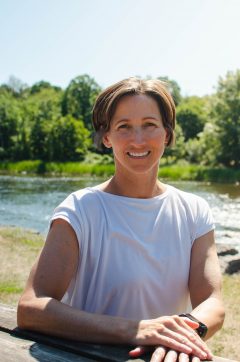Instructor Spotlight: Véronic Bézaire

Véronic Bézaire
Instructor III, Undergraduate Program Advisor, & Co-op Coordinator (Food Science)
Department of Chemistry (Food Science) and
Institute of Biochemistry
Bio
I joined the Food Science program in 2010. Prior to joining Carleton, I completed graduate and post-doctoral work in the fields of biochemistry and nutrition, and then worked at the Canadian Food Inspection Agency (CFIA). As an Instructor in the Food Science program and Department of Chemistry, my research interests have shifted to the scholarship of teaching and learning.
Education
Post-doc Institut de médicine moléculaire, Toulouse
PhD. Human Health and Nutritional Sciences, University of Guelph
BSc. Biochemistry, Université d’Ottawa
1.What drew you to Food Science?
I arrived to Food Science in a rather roundabout way. I chose (and loved!) biochemistry as an undergraduate degree. I then studied nutrition at the University of Guelph… that’s right, the university with the biggest and oldest Food Science program in Canada. I was even conducting research in the Food Science building but strangely, Food Science was not on my radar (!). After completion of my studies, I obtained my first ‘real job’ in the Chemical Evaluation group at the CFIA. It was this experience that made me realize how impactful work in food science is. I learned about food regulations and food safety monitoring activities and was simply _blown away_ by all that was being done to keep Canadians safe. I loved that my work in food science and food safety had so much impact on the daily life of Canadians. This was true ten years ago, is true today, and will continue to be true.
2. What courses do you teach at Carleton?
Currently, I teach four undergraduate courses, from 2nd to 4th year. I will be teaching an additional capstone course (FOOD 4905 Food Science Honours Workshop) this fall.
FOOD 2004 Scientific Writing in Food Science is really rewarding to teach. Firstly, I get to meet students early on in their Food Science program and see them grow intellectually over the course of their degree. Secondly, I get to teach students many valuable skills, from information literacy, to writing and presenting, that will help them succeed in their studies.
FOOD 3003 Food Packaging is much more than a cardboard box or plastic bag. It’s a fascinating area of food science that explores the barrier properties of packaging materials to environmental factors. It is also about active and intelligent forms of packaging that can sense deteriorative reactions in specific foods, neutralize those reactions or communicate them to manufacturers or consumers. The main outcome for this course is that students are equipped to propose suitable packaging materials for a variety of commodities, based on their respective deteriorative reaction profile.
FOOD 4201 Advanced Energy Metabolism is my first love. The regulation of human energy metabolism in different tissues and in different physiological states is so fascinating to me. That’s what lead me to graduate studies. It’s so relevant when trying to make sense of low carb diets, keto diets, intermittent fasting, and the rest of diets that come and go.
FOOD 4202 Micronutrients and Health explores the metabolism of micronutrients. Sure, we review traditional functions of micronutrients, but we also explore novel functions of micronutrients. We evaluate the strength of those novel functions by critiquing systematic reviews and meta-analyses. We even go through the steps of updating our own systematic review and meta-analysis. Thank you to awesome bioscience librarian Heather MacDonald for teaching us such important skills!
3. What high impact teaching practices do you bring to the Food Science program?
I am a big proponent of active learning practices. I think this stems from my personal experience as an undergraduate student. Unknowingly at the time, I was adopting my own active learning approaches to be successfully in my studies. Today, the literature in teaching and learning confirms the learning gains from active learning over passive learning despite student preference for passive learning. I try to adopt a scholarly approach to teaching, by incorporating elements of active learning in my courses, collecting data on their effectiveness, and adjusting accordingly.
I am also fascinated by course and curriculum design. I love going through the process of backward design, that is to identify learning outcomes for a course, plan forms of assessment to evaluate those outcomes, and then think of the content and skills required to achieve those outcomes. This is important within individual courses, but also at the program level, to help students make connections between courses. It’s a big change from the content-driven lectures from 20 years ago but it makes a lot of sense to me. I think my work experience outside of academia may help me appreciate the importance of outcome-based teaching and learning. I have seen that employers care not only about your knowledge, but what you can do with your knowledge.
4. What makes the Food Science Program at Carleton unique?
Food Science at Carleton is an interdisciplinary science program with elements of economics, regulations, and policy. This is precisely what employers seek in science graduates: sound scientific knowledge and transferable skills for a smooth transition to the workforce.
5. What is a fun fact about you?
I love trail running and wish I were a mountain goat.